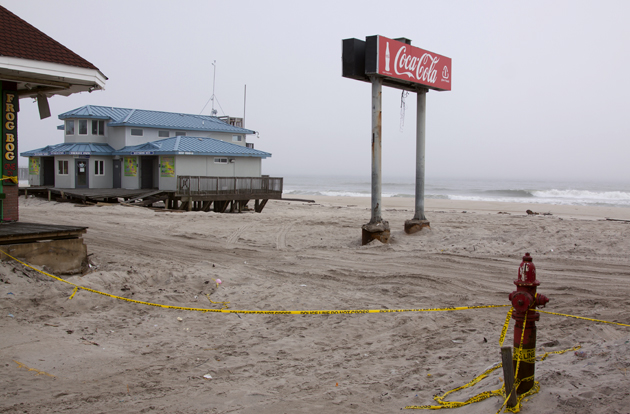 The scene in Seaside Heights, New Jersey, on January 13, 2013 — more than two months after Sandy hit. (Glynnis Jones / Shutterstock.com)[/caption]
The scene in Seaside Heights, New Jersey, on January 13, 2013 — more than two months after Sandy hit. (Glynnis Jones / Shutterstock.com)[/caption]While much of the Northeast was unprepared for Sandy, the insurance industry had been preparing for it for years. Ever since Hurricane Andrew in 1992, the insurance industry has taken steps to protect itself against catastrophe losses, in conflict with the interests of its customers.
The industry's principal tactic has been to draft policy provisions designed to curtail coverage. It has others, too: hiking premiums, refusing renewals in high-risk areas and delaying claims long enough to take advantage of the time value of money. Some companies also add “hurricane deductibles” or shift coverage to government-backed programs (such as the National Flood Insurance Program).
From the insurer's perspective, these efforts are working.
Insurance companies made record profits in the aftermath of Hurricane Katrina, for example. And despite the hits taken after September 11 and the economic downturn in 2008, they have developed enormous surpluses in recent years.
From the policyholder perspective, however, these are tactics that should be prohibited.
For that to happen, consumers, courts and state regulators need to compel insurance companies to honor their coverage obligations and stop protecting themselves.
Disputes Based on Policy Types
Property insurance policies fall into two types: “all risks” (which cover “all risks of direct physical loss or damage,” except those specifically excluded) and “named perils” (which cover damage or loss caused by listed perils — like fire, wind, hail or vandalism — but also contain exclusions, including for some weather conditions).
A typical commercial policy covers buildings and structures, personal property inside or on them, and personal property that is nearby or in a vehicle. These policies typically exclude coverage arising from flood, power failures and similar events.
Both types of policies call causation directly into question — and, unfortunately, causation can be difficult to assess.
The courts have developed various tests for determining the cause of a loss. The leading doctrine is “efficient proximate cause,” which focuses on the dominant cause. If the dominant cause is a covered peril, then there is coverage for it under this doctrine. In states that follow this doctrine, such as New Jersey and Connecticut, policyholders can obtain coverage when storm-related damages are caused by wind, rather than flood.
The insurance company antidote is a provision known as the “anti-concurrent causation” clause.
Such clauses typically state: “We will not pay for loss or damage caused directly or indirectly by any [excluded cause]. Such loss or damage is excluded regardless of any other cause or event that contributes concurrently or in any sequence to the loss.”
These clauses are designed to obliterate coverage whenever there is a single non-covered event, no matter how insubstantial or indirect. In the words of one district court judge, who rejected the clause as unenforceable: It "would mean that an insured whose dwelling lost its roof in high winds and at the same time suffered an incursion of even an inch of water could recover nothing under his Nationwide policy."
Some states refuse to enforce anti-concurrent causation clauses.
In Washington, for example, the state’s highest court ruled that insurance companies cannot circumvent the state’s “efficient proximate cause” rule by contract. Similar rulings in West Virginia, California and North Dakota. And more states can be expected to follow in the wake of Superstorm Sandy.
State governments serve as checks and balances in this system. Immediately following Sandy, for example, the governors of New York, New Jersey and Connecticut decreed through executive orders that hurricane deductibles are inapplicable because Sandy was a tropical storm – not a hurricane – when it made landfall.
The legal system provides recourse as well.
After Katrina, courts reviewed policyholder challenges to coverage denials and used state bad faith law to deter improper claim denials. While post-Sandy cases have barely begun to be filed, similar decisions may follow.
The ultimate lesson from Katrina is that it is time to bear down on insurance companies that put their own interests ahead of their policyholders’ interests. Still, insurance buyers must do their part by challenging wrongful denials.
With diligent oversight by policyholders, governmental entities and courts, insurers that use unjust tactics will find themselves with serious legal problem that extend far beyond the details of any single claim.
